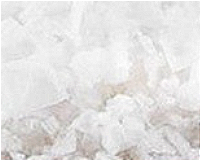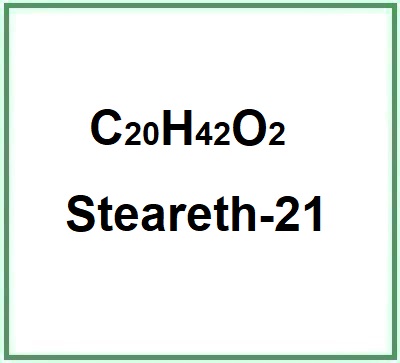Steareth-21 is a chemical compound, carbon chains alkyl polyethylene glycol (PEG (Polyethylene glycol)) ether of ethoxylated fatty stearyl alcohol (21 mol), from palm kernel oils and coconut oils and fats.
The name describes the structure of the molecule:
- Stear derives from the term "stearyl," referring to the residue of stearyl alcohol, a fatty alcohol with 18 carbon atoms. It's the lipophilic (or hydrophobic) component of the molecule, meaning it has a preference for oily or fatty substances.
- eth indicates that the original stearyl alcohol molecule has been ethoxylated, meaning ethylene oxide units have been added to the alcohol's OH group. The ethylene oxide imparts hydrophilic (or water-soluble) properties to the molecule.
- 21 indicates the average number of ethylene oxide units added to the original molecule. This number can influence the surfactant's solubilizing and emulsifying properties.
Raw Materials Used in Production.
Steareth-21 is a non-ionic surfactant derived from the ethoxylation of stearyl alcohol. Stearyl alcohol is typically obtained from fats and oils of both animal and vegetable origins, particularly from stearate, a fatty acid.
Step-by-step Summary of Industrial Production Process.
- Preparation of stearyl alcohol. Extracted from oils or fats through hydrogenation.
- Ethoxylation. The stearyl alcohol is then reacted with ethylene oxide under specific conditions to introduce ethoxylate groups, forming Steareth-21.
- Purification. Any impurities or by-products are removed through processes like distillation or filtration.
Form and Color.
It appears as a waxy solid or as a viscous liquid depending on the concentration and preparation. It is generally colorless or white.

What it is used for and where
It is a non-ionic lipophilic surfactant with the function of an emulsifier for water/oil emulsions. Emulsifiers have the property of directly influencing the stability, sensory properties and surface tension of sunscreens by modulating their filmometric performance.
Pharmaceutical
Co-emulsifier for oil/water systems with excellent dispersing power and resistant to extreme pH values and high concentrations of electrolytes and metal ions.
Cosmetics
Emulsion stabilizer. Emulsions are thermodynamically unstable. Emulsion stabilisers improve the formation and stability of single and double emulsions. It should be noted that in the structure-function relationship, molar mass plays an important role.
Surfactant - Emulsifying agent. Emulsions are thermodynamically unstable and are used to soothe or soften the skin and emulsify, so they need a specific, stabilising ingredient. This ingredient forms a film, lowers the surface tension and makes two immiscible liquids miscible. A very important factor affecting the stability of the emulsion is the amount of the emulsifying agent. Emulsifiers have the property of reducing the oil/water or water/oil interfacial tension, improving the stability of the emulsion and also directly influencing the stability, sensory properties and surface tension of sunscreens by modulating the filmometric performance.
Cleansing agent. Ingredient that cleanses skin without exploiting the surface-active properties that produce a lowering of the surface tension of the stratum corneum.
Surfactant - Cleansing agent. Cosmetic products used to cleanse the skin utilise the surface-active action that produces a lowering of the surface tension of the stratum corneum, facilitating the removal of dirt and impurities.
Commercial Applications
Cosmetics Industry. Steareth-21 is an emulsifying agent commonly used in skincare products and cosmetics. It helps mix water-based ingredients with oil-based ones, forming a smooth consistency.
Personal Care Products. It can be found in lotions, creams, foundations, cleansers, and other skincare items.
Safety.
The term 'eth' refers to the ethoxylation reaction with ethylene oxide after which residues of ethylene oxide and 1,4-dioxane, chemical compounds considered carcinogenic, may remain. The degree of safety therefore depends on the degree of purity of the compound obtained. At present, no manufacturer is known to provide this information on the label.
Steareth-2 studies
Typical commercial product characteristics Steareth-21
| Appearance | White crystals |
Boiling Point
| ~43*C |
| Melting Point | 56-60ºC |
| Flash Point | 154.2ºC |
| Density | 0.867g/cm3 |
| Safety |
|
- Molecular Formula C20H42O2
- Molecular Weight 314.5
- CAS 9005-00-9
- UNII V56DFE46J5
- EC Number 500-017-8
- DSSTox Substance ID DTXSID7029299 DTXSID60858842
- IUPAC 2-octadecoxyethanol
- InChI=1S/C20H42O2/c1-2-3-4-5-6-7-8-9-10-11-12-13-14-15-16-17-19-22-20-18-21/h21H,2-20H2,1H3
- InChl Key ICIDSZQHPUZUHC-UHFFFAOYSA-N
- SMILES CCCCCCCCCCCCCCCCCCOCCO
- MDL number
- PubChem Substance ID
- ChEBI
- NACRES NA.24
- RTECS
Synonyms:
- 2-Octadecoxyethanol
- Brij 76
- Brij 78
- 2-(Octadecyloxy)ethanol
![]() Steareth-21
Steareth-21 






